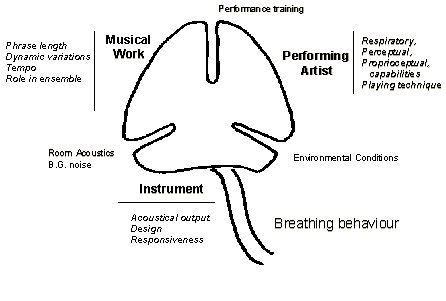
Respiration and breathing are keywords in this thesis, since they play a central role in wind instrument playing as well as in voice production. In wind instrument playing and in singing the performer shares the vital metabolic air with the sound-producing organ. In a more general perspective, respiratory pauses and sometimes even respiratory sounds contribute significantly to music performance, also in the case of some non-wind instruments. For instance, in the playing of bowed string instruments, western classical performers frequently employ the sounds and gestures of respiration to enhance expressiveness and also to mark musical phrases. Thus, breathing and the associated pauses serve as structural elements in musical performance, often possessing a significant esthetical content.
This study comprises a suite of papers conceived with the intention to examine the theme under an interdisciplinary perspective, including musical, acoustical, perceptual and physiological aspects. It is concentrated on the mechanical-reed woodwinds, henceforth reed woodwinds, which comprise the oboe, clarinet, saxophone and bassoon. This interdisciplinary approach is justified by the assumption that it is not possible to fully understand the process of playing a wind instrument if any of these aspects is overlooked in the analysis. Figure 1 shows a schematic representation of the breathing behaviour in wind instrument playing.

Figure 1. Illustration, in the form of a trefoil diagram, of the phenomenon of breathing behaviour in wind instrument playing. As shown, breathing needs to accommodate demands originating from three main systems: performer, instrument and musical work.
As schematically illustrated in Figure 1, breathing behaviour in wind instrument playing is influenced by a great number of different factors, each raising demands on the player's performance. The structural organisation of the music imposes certain requirements regarding tempo, phrase length, dynamic variation, and the musical role in the ensemble. The performing artist has to accommodate these demands within the constraints and potentials of his own physiological system, including respiratory, perceptual, and proprioceptual capabilities. The instrument consumes air, provided by the player’s metabolic system. It consumes air to an extent that depends on many factors, such as the desired acoustical output, the technique of playing, and the responsiveness of the instrument. The task of the musician is to harmonise all these factors so as to reach a satisfactory artistic end result. Many of these factors have been neglected in previous investigation of wind instruments. Conversely, some research in the area of respiration may profit from improved information about breathing characteristics of wind instrumentalists. Likewise, the understanding of the function of wind instruments, as well as of the musical work and its performance, may gain from information about the physiology of the player. In addition, the knowledge gathered and produced in this thesis may have applications in the development of new playing techniques, the designing and improving of instruments, in compositional work, as well as in the development of computer algorithms for artificial instruments. From a wider perspective, the thesis can be regarded as a meeting point of several disciplines, such as musical acoustics, instrument making, music theory, physiology, ergonomics, and instrumental practice.
©1998 by Leonardo Fuks